Florence Jones, Top Doctor
We’ve spent the last year combing through every scrap of film footage we shot, or were able to collect from others, in order to tell Winnemem Wintu medicine woman Florence Jones’ (1907-2003) life story in our most recent Audio Archive episode. But even that episode—soon to be included in our new “Sacred Land Speaks” podcast—doesn’t tell the full story. These photos and narrative supplement the podcast hour. We advise that you listen to the podcast first, and then check out this blog. (Well, it’s okay if you want to peek at the photos first!)
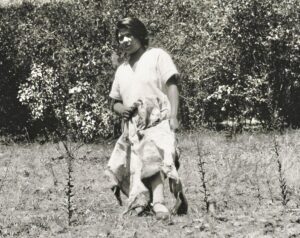
Young Puilulimet holding a deer hide, photographed by linguist and ethnologist J.P. Harrington, along the McCloud River.
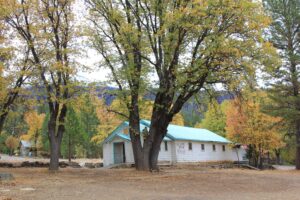
Greenville Indian School, where the main building burned down on December 17, 1921. This is the church, photographed 100 years later, in 2021.
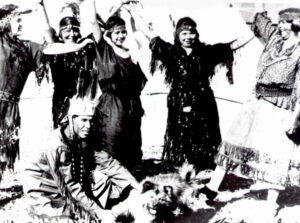
Florence, a spirited teenager, second from right, dancing in San Francisco in 1924.
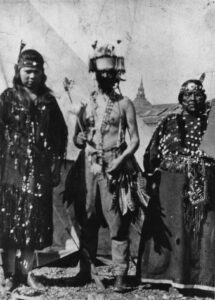
Florence and her parents, William and Jennie Curl, in San Francisco in 1924.
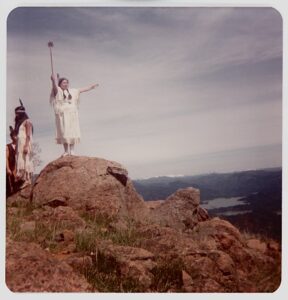
Florence performs a ceremony on Bear Mountain in 1973, which was illegal under U.S. law at the time, as the 66-year-old top doctor passes Winnemem traditions on to the younger generation.

Florence Jones photographed in the 1970s by Peter Knudtson for his book The Wintun Indians.
In the 1970s, Florence spent time with author Peter Knudtson and described her spiritual doctoring for his book The Wintun Indians. “The spirits use me for just a tool,” Florence told Knudtson, “something to get into to tell the people what is going to happen and what they can do…This is what the spirit tells me: Get my people together…Whoever has sacred places must wake them up, the same as I am doing here.”
Knudtson explained the medicine woman’s healing practice: “Wintu helping spirits take many forms—they may be spiritual forces residing in sacred places or celestial bodies, the spirits of animals, or the souls of departed relatives, among others. Flora’s own pantheon of spirit helpers contains representatives of each, acquired through long years of doctoring experience, and each is endowed with its own personality and usefulness.”
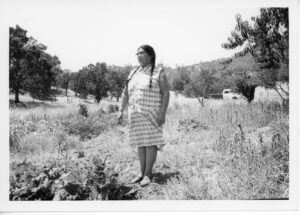
Florence Jones photographed by Peter Knudtson for his book The Wintun Indians.
As described by Knudtson, Florence was a healing doctor, the highest of five kinds of Wintu doctors (“dreamers” and “singers” were clairvoyant but not healers, “tracers” located lost objects or souls, and finally “sucking doctors” who sucked out the malady, and “healing doctors”). Florence diagnosed illnesses with her hands during a trance that was like an ecstatic healing séance. First, she would summon her helping spirits by singing the appropriate song. She smoked tobacco to enter a trance state. The arrival of a helping spirit was marked by a sharp inhalation, and then the spirit spoke through the shaman’s voice, offering advice or prophecy. An interpreter translated what Florence said while in trance. The shaman drank clear water as an offering to the spirit. Her hands touched the body of the sick person, feeling for pain. “Any place they are hurting, I hurt,” Florence told Knudtson. “I become a part of their body.” Then the spirit prescribed the needed herbal medicine. Awakening from the trance, the medicine woman learned of the spirit’s diagnosis from her interpreter and proceeded to treat the patient.
Though I was never able to get Florence Jones to sit for a formal interview when we filmed her between 1994 and 1999, she was very comfortable with verité scenes where she could say and do as she pleased. Our first day of filming with Florence was in August 1994, a beautiful sunset scene around the fire at Coonrod Flat below Mt. Shasta. This was the first of three ceremonies Florence wanted us to film that weekend.
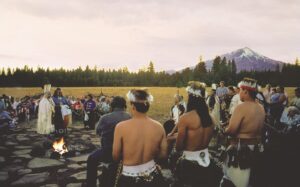
Fire Ceremony at Coonrod, 1994
On our third day of filming, we spent the afternoon in Panther Meadows recording a dramatic healing ritual that had been conducted for centuries by Winnemem top doctors and spiritual practitioners at a sacred spring near the tree line on Mt. Shasta.
One year before, while getting to know Florence and scouting for possible film scenes, I witnessed this ceremony, and participated, as was required of everyone present. I stood above the spring, prayed aloud, and looked down into swirling sands. I was mesmerized by the bubbles that rose and burst, sending waves rippling out across the water in expanding circles. My mind was silenced. Time stopped. I was stunned by the beauty of a spring that was clearly communing with the people. I felt transformed. The mysterious power of a spirited spring bubbling up from the side of a sacred mountain opened my heart.
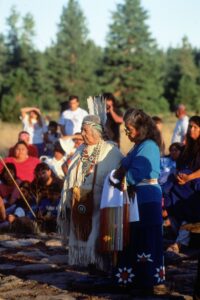
Florence with Mary Norton
A year later, as we arrived at the spring, Florence encountered a disturbing scene. Rocks had tumbled haphazardly into the water. New Agers had left crystal offerings all over the place. The Forest Service had failed to widen the trail as promised, so Winnemem men were forced to carry Florence in her wheelchair down a half mile of rocky trail.
Florence felt frustrated, insulted, and she quickly voiced her feelings. “I’m disgusted,” she lamented, “and so is my spring.”
It was an incredible scene, and it stretched on for hours. Florence smoked her pipe, prayed and sang. At one point she looked directly at the camera and spoke for ten minutes. We shot all our film—very expensive, limited supply—and then switched to videotape—cheaper, unlimited supply. The scene unfolded over four or five hours, and it was traumatic and stressful for everyone.
There were two aspects of the story that I didn’t feel comfortable including in the podcast about Florence’s life.
The first issue: Why didn’t we delve into what really happened at the spring in our film In the Light of Reverence? Time constraints is the easy answer. The scene plays out in the podcast over twelve minutes. Florence was upset. She was angry. She prayed to her two sacred mountains, received an answer, and then challenged everyone present with a question: “Do you want Mt. Shasta to blow up?… I can pull that string that the Creator gave me to pull to end the world.” For me, this was incredibly intense in the moment, during a film shoot (…and also in the editing room—another story about that in a moment). To do the scene justice would have taken at least four or five minutes in our film, which we struggled to bring in at 72-minutes for PBS broadcast. We simply did not have the time. But more to the point, my rational mind had trouble processing and understanding what I witnessed. I guess it scared me. I did not know what to make of Florence’s angry threat to destroy the mountain, to end the world. Furthermore, I worried about how an audience would react if we presented the full scene. We had witnessed (and filmed) a medicine woman go on a classic shamanic journey. Florence returned from trance with a startling message and a dramatic challenge. I didn’t know how our film audience would perceive the scene. Would they doubt the top doctor? Judge her? Assail what we presented? To be honest, I questioned whether Florence was performing for the camera. It was pure drama, the angry challenge Florence directed at her adversaries, “the Forest Service,” the “white people” and “even the cameraman.”
The second element of the story we left out of the podcast was an explanation of the disturbing sound you can hear in the background as Florence reaches the intense climactic conclusion of her trance song. In the background, as she is clapping her hands and exhaling three healing breaths, you can hear Florence’s translator, Emerson Miles, vomiting. He retches five or six times, loudly. The top doctor was purging the toxicity and imbalance of the place and the people, healing everyone and everything. To do so, it seems that her helper needed to physically suffer, and literally expel the poisons.
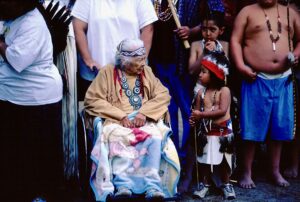
Florence and Daniel Scholfield
All of this was vividly in my mind as we struggled to digitize the footage of Florence at the spring and transfer it onto hard drives for editing. Every time our editor Will Parrinello tried, the computer crashed. Will would try one more time and the computer crashed again. Will shut everything down, restarted, and the computer refused again. He reloaded the operating system software to no avail as the system crashed again. After two hours of trying unsuccessfully, there was a knock on the editing room door. Feeling hassled, I opened the door as I looked at my watch and remembered that I had scheduled a job interview with filmmaker Malinda Maynor (Lumbee), who had recently graduated from Stanford’s Communication and Film master’s degree program. Malinda had arrived to discuss working with us as co-producer. To this puzzled young woman I’d never met, I blurted out, “I’m really sorry, but we’re having trouble digitizing some sensitive footage and I’m going to have to delay the interview for a while. Can you wait?” Malinda kindly agreed to wait. An hour later, after we had smudged the editing room and the footage had at last somehow succumbed to being digitized, I left the editing room, met with Malinda, and immediately offered her the co-producer job. We worked together for four years, and Malinda—along with Will and writer Jessica Abbe—deserve the major credit for making In the Light of Reverence a transformational film that is still in wide use 20 years after it was completed. Florence Jones deserves a lot of the credit too.
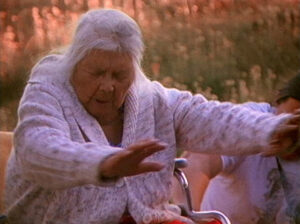
Florence in trance, singing to her spring
But I found out in 2017, when I asked Winnemem Chief Caleen Sisk if Florence had the power to blow up her sacred mountain on that memorable afternoon at the spring, that Florence didn’t deserve all the credit.
“That was the mountain,” replied Caleen. “As far as I understand it, those words were the mountain’s words. It was not necessarily her saying, ‘I’ll bring the mountain down.’ But she was saying to the people: ‘Is that what you want me, the mountain, to do?’ Not Grams, not her power to take down the mountain. You really don’t have that kind of ability when you’re dealing with a huge sacred being.”
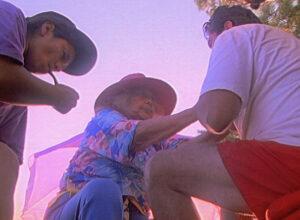
Florence healing her people in a scene from In the Light of Reverence
A shaman goes on a journey, comes back with a message, and heals land and community. We witnessed it. I felt it. We filmed it. But I am chagrined to admit how conflicted I felt at the time. Is the world ready for this? I asked myself. How will this scene be received? Now we get to find out. Twenty years later, I feel an undeniable responsibility to share what we filmed, for the historical record.
Florence wanted us to tell her story, her full story, and that’s what we’re still trying to do.
You can watch In the Light of Reverence at Vimeo on Demand, for a $4 rental fee. Enjoy!
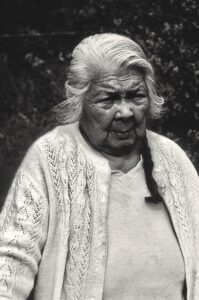
Florence Jones (1907-2003)